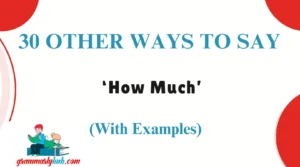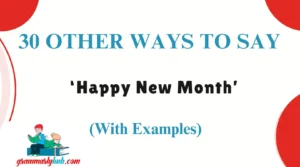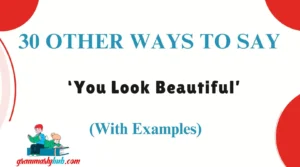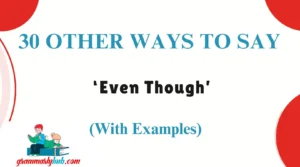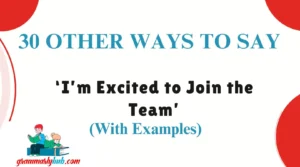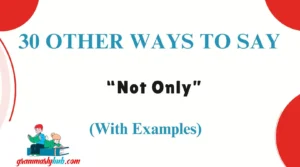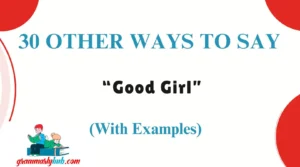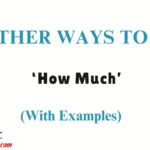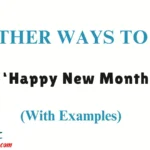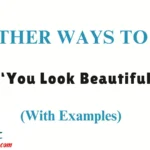Finding the right words to express uncertainty or lack of knowledge can be more meaningful than just saying the simple phrase, “I don’t know.” When you want to communicate with warmth, care, and thoughtfulness, choosing an alternative can soften the message and make conversations feel more personal.
Whether you’re talking to a friend, colleague, or someone you respect, these alternatives help express honesty without sounding abrupt or dismissive. In this article, you’ll discover 30 empathetic and polite ways to say “I don’t know,” complete with definitions, examples, and guidance on when and how to use each one effectively. Let’s make your communication more nuanced and genuine!
What Does “I Don’t Know” Mean?
“I don’t know” means admitting a lack of knowledge or information about something. It’s a straightforward way to express uncertainty or that you haven’t found an answer yet. While simple, it can sometimes feel blunt or too direct depending on the context.
When to Use “I Don’t Know”
This phrase is often used in everyday conversations, professional settings, or when someone asks a question outside your expertise. It’s best used when honesty is important, but you want to avoid giving false or misleading information.
Is It Professional/Polite to Say “I Don’t Know”?
Yes, it’s generally acceptable to say “I don’t know,” especially when followed by a willingness to find the answer. However, using more thoughtful alternatives can make the communication feel more polished and empathetic, especially in professional or sensitive situations.
Pros and Cons of Saying “I Don’t Know”
Pros:
- Honest and clear
- Simple and direct
- Avoids confusion or misinformation
Cons:
- Can sound dismissive or abrupt
- May seem like a lack of effort
- Sometimes perceived as unprofessional without context
Synonyms For “I Don’t Know”
- I’m not sure
- I have no idea
- I’m uncertain
- I can’t say for sure
- That’s a good question
- I’m not the best person to ask
- I haven’t figured that out yet
- It’s unclear to me
- I’m still learning about that
- I don’t have that information right now
- I need to check on that
- I’m not familiar with that
- I can’t give you an answer at the moment
- Let me get back to you on that
- I don’t have the details
- I haven’t come across that before
- I’m not confident enough to answer that
- I’m not up to date on that
- That’s beyond my knowledge
- I don’t have an answer for that right now
- I’m unsure about that
- I don’t want to mislead you
- That’s outside my expertise
- I’ll need more information
- I can’t provide a definite answer
- I’m not equipped to answer that
- That’s something I’ll have to look into
- I don’t have enough information to say
- I’m still gathering facts
- I’m unable to answer that at this time
1. I’m not sure
Definition: Expressing a polite level of uncertainty without completely closing the door on knowing.
Explanation: This phrase softens the admission of uncertainty, implying you might find out later or need more thought.
Example: “I’m not sure if the meeting is tomorrow or next week. Let me check.”
Worst Use: When you should have known the answer but use it to avoid responsibility.
Tone: Polite, open, thoughtful
2. I have no idea
Definition: A casual, honest admission of complete lack of knowledge on the topic.
Explanation: More informal and direct, best used in relaxed settings with people you know well.
Example: “I have no idea how to fix this software bug.”
Worst Use: In formal or professional environments where it may seem too blunt.
Tone: Casual, honest, sometimes blunt
3. I’m uncertain
Definition: A more formal way to express doubt or lack of clarity.
Explanation: Useful in professional or academic contexts where precision is important.
Example: “I’m uncertain about the final results until the data is reviewed.”
Worst Use: When an immediate answer is expected or when it sounds evasive.
Tone: Formal, cautious, respectful
4. I can’t say for sure
Definition: Indicates that you don’t have enough information to give a definite answer.
Explanation: Shows openness but also honesty about limitations.
Example: “I can’t say for sure if the event will be postponed.”
Worst Use: When an answer is necessary, and delay causes issues.
Tone: Honest, cautious, considerate
5. That’s a good question
Definition: A way to acknowledge the question positively while avoiding an immediate answer.
Explanation: Softens the admission of not knowing and shows appreciation for the question’s thoughtfulness.
Example: “That’s a good question; I’ll have to think about it.”
Worst Use: If overused, it may seem like avoiding answers.
Tone: Positive, thoughtful, encouraging
6. I’m not the best person to ask
Definition: Redirecting responsibility politely when the answer lies elsewhere.
Explanation: Shows awareness of your limits and directs the conversation appropriately.
Example: “I’m not the best person to ask about taxes, but I can connect you with someone who is.”
Worst Use: When used to avoid taking ownership.
Tone: Polite, humble, helpful
7. I haven’t figured that out yet
Definition: Suggests ongoing effort to find the answer.
Explanation: Communicates that you’re actively seeking the information.
Example: “I haven’t figured out the best solution yet, but I’m working on it.”
Worst Use: If used repeatedly without progress.
Tone: Honest, proactive, optimistic
8. It’s unclear to me
Definition: Indicates that the information is confusing or incomplete.
Explanation: Useful in professional discussions to express confusion without blame.
Example: “It’s unclear to me how the new policy will affect us.”
Worst Use: When it seems like an excuse to avoid responsibility.
Tone: Thoughtful, honest, cautious
9. I’m still learning about that
Definition: Expresses a humble admission of ongoing learning.
Explanation: Shows openness to growth and transparency.
Example: “I’m still learning about the software updates, so I don’t have all the details yet.”
Worst Use: When you should have mastered the topic.
Tone: Humble, open, patient
10. I don’t have that information right now
Definition: A straightforward, polite way to say the info isn’t currently available.
Explanation: Keeps the door open to provide info later.
Example: “I don’t have that information right now, but I can find out.”
Worst Use: If info is crucial and delay is harmful.
Tone: Polite, clear, responsible
11. I need to check on that
Definition: You don’t know now, but you’re willing to find out.
Explanation: This response shows initiative and a desire to provide accurate information rather than guess.
Example: “I need to check on that before giving a definite answer.”
Worst Use: When you say it but have no intention of actually checking.
Tone: Responsible, polite, proactive
12. I’m not familiar with that
Definition: Admits that the subject is outside your current knowledge.
Explanation: This phrase communicates honesty while staying professional and composed.
Example: “I’m not familiar with that software, but I’m happy to learn more.”
Worst Use: In situations where basic familiarity is expected.
Tone: Honest, respectful, open
13. I can’t give you an answer at the moment
Definition: Indicates a temporary inability to provide an answer.
Explanation: Suggests that more time, information, or clarity is needed before responding.
Example: “I can’t give you an answer at the moment, but I’ll follow up soon.”
Worst Use: When used to avoid answering indefinitely.
Tone: Polite, professional, non-defensive
14. Let me get back to you on that
Definition: A promise to provide the answer later.
Explanation: It’s a courteous way to postpone an answer while assuring a follow-up.
Example: “Let me get back to you on that after I double-check the numbers.”
Worst Use: If you forget or never follow through.
Tone: Thoughtful, responsible, courteous
15. I don’t have the details
Definition: A way to express that you lack full or accurate information.
Explanation: Best when partial knowledge isn’t enough to provide a complete response.
Example: “I don’t have the details yet, but I can find out.”
Worst Use: In situations requiring you to be prepared with details.
Tone: Honest, informative, non-dismissive
16. I haven’t come across that before
Definition: You’ve never encountered the topic or situation.
Explanation: A kind, humble way to express unfamiliarity.
Example: “I haven’t come across that before—sounds interesting!”
Worst Use: In urgent decisions where familiarity is crucial.
Tone: Curious, genuine, respectful
17. I’m not confident enough to answer that
Definition: You don’t feel certain enough in your knowledge to give a reliable response.
Explanation: Communicates a sense of responsibility and care in giving accurate answers.
Example: “I’m not confident enough to answer that without double-checking.”
Worst Use: When used too often, it may appear insecure.
Tone: Careful, thoughtful, integrity-focused
18. I’m not up to date on that
Definition: Indicates outdated or incomplete knowledge on the topic.
Explanation: A tactful way to say you haven’t reviewed the most recent information.
Example: “I’m not up to date on the new policy changes yet.”
Worst Use: When your role demands you to be current.
Tone: Professional, responsible, realistic
19. That’s beyond my knowledge
Definition: Recognizes the question is outside your current expertise.
Explanation: A respectful way to acknowledge personal limits.
Example: “That’s beyond my knowledge, but I know someone who might help.”
Worst Use: If used to avoid learning something new.
Tone: Honest, humble, self-aware
20. I don’t have an answer for that right now
Definition: Admits current lack of information, with a subtle intent to return with an answer.
Explanation: Softens the statement by specifying it’s just “for now.”
Example: “I don’t have an answer for that right now, but I’ll look into it.”
Worst Use: If it becomes a delay tactic.
Tone: Warm, tactful, forward-thinking
21. I’m unsure about that
Definition: Communicates a level of uncertainty without denying possible knowledge.
Explanation: Suggests you’re still processing or uncertain about details.
Example: “I’m unsure about that answer—let me check before I confirm.”
Worst Use: When used vaguely, without intent to clarify.
Tone: Reflective, respectful, gentle
22. I don’t want to mislead you
Definition: A clear sign of honesty and responsibility.
Explanation: Emphasizes the desire to give truthful and accurate information.
Example: “I don’t want to mislead you, so I’ll look into it first.”
Worst Use: If used to deflect responsibility.
Tone: Sincere, trustworthy, careful
23. That’s outside my expertise
Definition: Indicates that you’re not trained or experienced in that area.
Explanation: Helps redirect questions to someone more qualified.
Example: “That’s outside my expertise, but I can refer you to someone who knows.”
Worst Use: When you actually do have relevant experience but feel unconfident.
Tone: Humble, professional, respectful
24. I’ll need more information
Definition: You can’t answer yet because key facts are missing.
Explanation: Shows interest but sets clear boundaries on what you can answer without clarity.
Example: “I’ll need more information before I can give a proper answer.”
Worst Use: When it becomes a stall for making decisions.
Tone: Honest, constructive, inquisitive
25. I can’t provide a definite answer
Definition: Expresses doubt about giving a confirmed or conclusive reply.
Explanation: Suitable when you don’t want to make a guess or assumption.
Example: “I can’t provide a definite answer until I review the data.”
Worst Use: When a clear answer is expected and required.
Tone: Diplomatic, prudent, respectful
26. I’m not equipped to answer that
Definition: You lack the tools, resources, or background to answer effectively.
Explanation: Useful when you don’t want to overstep your role or expertise.
Example: “I’m not equipped to answer that from a legal perspective.”
Worst Use: When used as an excuse instead of seeking support.
Tone: Honest, humble, appropriate
27. That’s something I’ll have to look into
Definition: Expresses willingness to investigate further.
Explanation: Signals that while you don’t have the answer, you’re committed to finding it.
Example: “That’s something I’ll have to look into and get back to you.”
Worst Use: When you never follow through.
Tone: Supportive, helpful, accountable
28. I don’t have enough information to say
Definition: You don’t feel you have sufficient knowledge to respond accurately.
Explanation: Protects against giving wrong or premature answers.
Example: “I don’t have enough information to say right now.”
Worst Use: If you repeatedly avoid decisions using this phrase.
Tone: Cautious, honest, protective
29. I’m still gathering facts
Definition: Indicates ongoing research or understanding.
Explanation: Shows you’re engaged in learning, but not ready to comment yet.
Example: “I’m still gathering facts, but I’ll update you once I have a clearer view.”
Worst Use: If used when no fact-finding is actually happening.
Tone: Proactive, thoughtful, honest
30. I’m unable to answer that at this time
Definition: Politely expresses a current inability to provide an answer.
Explanation: Useful in formal settings, especially when confidentiality or timing is a concern.
Example: “I’m unable to answer that at this time due to ongoing reviews.”
Worst Use: When used repeatedly without offering future clarity.
Tone: Formal, careful, respectful
Conclusion
Choosing how to say “I don’t know” doesn’t just reflect your knowledge—it reflects your character, empathy, and communication style. Whether you’re in a meeting, chatting with a friend, or speaking publicly, using thoughtful alternatives helps you sound caring, genuine, and composed. These 30 phrases give you the flexibility to express uncertainty without sounding unkind or unprofessional. When you acknowledge your limits with grace, you build trust—and that’s something even more powerful than always having the right answer.
FAQs
How can I choose the best alternative phrase?
Consider your relationship with the listener and the formality of the setting. For a casual chat, options like “I have no idea” or “That’s a good question” work well. In professional contexts, phrases such as “I’m not familiar with that” or “I’ll need more information” convey honesty and responsibility.
What if I need to respond immediately?
Use phrases that buy you a bit of time without cutting off the conversation. For example:
- “I can’t give you an answer at the moment.”
- “Let me get back to you on that.”
Are there any alternatives that sound more empathetic?
Yes—phrases like “I don’t want to mislead you”, “That’s beyond my knowledge”, or “I’m still gathering facts” not only admit uncertainty but also show you care about giving accurate, helpful information.
Can I use these in written communication (emails, reports)?
Absolutely. For written and formal contexts, prefer more polished alternatives:
- “I’m not up to date on that.”
- “I can’t provide a definite answer.”
- “I’m unable to answer that at this time.”
How do I follow up after using one of these phrases?
Always indicate your next step or offer to help further:
- “I need to check on that—let me circle back.”
- “I’ll look into it and update you.”
- “I’ll refer you to someone who knows more.”

Emma Brooke is the voice behind Grammarly Hub, where grammar meets clarity. With a deep passion for the written word, Emma helps readers navigate the tricky waters of English grammar, writing tips, and effective communication.


